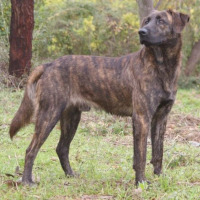Appearance of the Treeing Tennessee Brindle
|
| The Treeing Tennessee Brindle is a medium-sized Cur. The coat of the Treeing Tennessee Brindle is short, dense and soft. The breed can be brindle or black with brindle edging. It can sometimes have small white markings on the chest and feet. The feet are round and well arched. The dewclaws of its long, muscular legs are usually removed. This breed of dog has a deep chest, muscular neck and well-proportioned body. The tail is thick at the base, tapering to the tip. The muzzle is slightly broad and long, with a strong jaw. The breed has a broad, flat skull that tapers toward the muzzle. The cheeks of the Treeing Tennessee Brindle are muscular and the lips are tight with a scissor bite. Ears are pendulous and V-shaped. Eyes may or may not be dark brown or amber, and the nose is black. This agile dog has a supple, effortless gait. |
Temperament of the Treeing Tennessee Brindle
|
| The Treeing Tennessee Brindle has a strong hunting instinct and is very courageous. During a hunt, the dog bleats, which means it calls out loudly to the hunter. They are highly intelligent, agile and have an extraordinary sense of smell. The Treeing Tennessee Brindle is an active, outgoing breed that needs daily exercise. He's friendly with other dogs and strangers, but he's a good watchdog and will bark to warn you of visitors. He is not generally an aggressive dog and does not make a good watchdog. Puppies need to be trained and socialized from an early age. As a companion, the Treeing Tennessee Brindle is an affectionate and loving pet. He loves children, but because of his high energy level, it's best if he's accompanied by older children. The Treeing Tennessee Brindle is not meant to be an apartment dog. He's best suited to a home with a large yard or farm where he can run, play and explore. |
Needs and activities of the Treeing Tennessee Brindle
|
| Due to their hunting nature, Treeing Tennessee Brindle have high energy levels that need to be expended every day. Walks of several miles, hikes in the woods and dog sports are all ways to keep your Treeing Tennessee Brindle dog satisfied. Treeing Tennessee Brindle can thrive on competitive sports like freestyle frisbee and agility, which are also great ways to bond with them. Many places host dog competitions, which may be something to consider as your puppy starts to grow up. Before starting a high-impact sport like agility, consult your vet to make sure your dog is healthy enough to participate. Treeing Tennessee Brindle are designed to learn quickly, so training shouldn't be too difficult with this breed. Consistent, confident training is essential for your Treeing Tennessee Brindle, avoiding overly harsh methods that will develop resentful behavior. As they can be a little difficult for new dog owners, a professional trainer with experience in Treeing and hounds can guide you in training your new Treeing Tennessee Brindle puppy. |
Maintenance of the Treeing Tennessee Brindle
|
| The short coat of the Treeing Tennessee Brindle is easy to care for. A weekly brushing is recommended to remove dead hairs, and a bath is only necessary if it's very dirty. They are vocal and have a unique, loud bark, which is not acceptable for apartment living. The Treeing Tennessee Brindle is a very energetic dog that requires more than daily walks. This breed of dog needs an active owner who will take him hunting, into the trees and on hikes. They love space to roam, explore and use their tracking instincts. Because the Treeing Tennessee Brindle is an active dog, it needs a high-protein diet. This breed thrives best in cooler environments. Treeing Tennessee Brindle dogs kept outdoors need adequate shelter during the winter months. |







 English (United Kingdom)
English (United Kingdom)